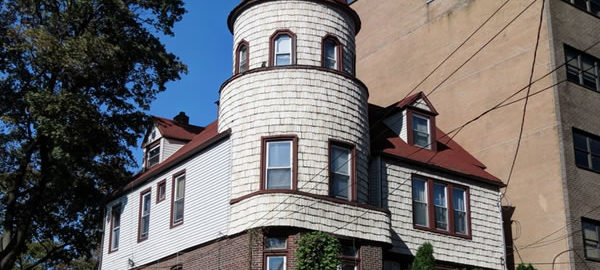Although there are hundreds of thousands of buildings in New York City, designed over the course of 400 years by thousands of architects, there are relatively few architectural style categories. The “AIA Guide to New York City” lists just 10 style categories, including “The Picturesque,” which in turn includes the sub-categories Romanesque Revival, Stick, Shingle, and Queen Anne.
Romanesque Revival, according to AIA Guide, is more common in Chicago. It is based on medieval bold arch and vault construction. (You may also see this style referred to as Rundbogenstil or Round Arch Style.)
Stick style makes its wood skeleton visible, as in half-timbered construction.
Queen Anne style is marked by strong vertical emphasis (tall windows, high-peaked roofs, etc.) and elaborate ornamentation. Queen Anne style buildings frequently include turrets.
Shingle style grew out of Queen Anne style, using wood shingles as its protective/decorative veneer. Originated in New England.
AIA Guide: p. xii.

 What Style Is It?
What Style Is It?
John C. Poppeliers, S. Allen Chambers Jr. | 152 pages | John Wiley & Sons | 2003
Architects and architectural writers toss around style classifications like confetti. The “AIA Guide to New York City Architecture” lists 10 main style groups, most of which have two to four sub-types. It’s easy to get lost.
Fortunately, this slim volume describes and amply illustrates 25 architectural styles, so you can quickly tell the difference between Romanesque Revival and Gothic Revival. The one thing that I found odd is that the authors seemed to go out of their way to avoid showing any New York City-based examples of any style, even when New York has the most and best examples of that style. Oh well.

![IMG_4073_4_5Adjust [10/22/2011 10:40:29 AM] IMG_4073_4_5Adjust [10/22/2011 10:40:29 AM]](https://www.newyorkitecture.com/wp-content/gallery/style-picturesque/img_4073_4_5adjust.jpg)
![IMG_4250_1_2Adjust [10/22/2011 12:58:56 PM] IMG_4250_1_2Adjust [10/22/2011 12:58:56 PM]](https://www.newyorkitecture.com/wp-content/gallery/style-picturesque/img_4250_1_2adjust.jpg)
![IMG_4361_2_3Adjust [10/22/2011 1:40:01 PM] IMG_4361_2_3Adjust [10/22/2011 1:40:01 PM]](https://www.newyorkitecture.com/wp-content/gallery/style-picturesque/img_4361_2_3adjust.jpg)
![IMG_4370_1_2Adjust [10/22/2011 1:43:08 PM] IMG_4370_1_2Adjust [10/22/2011 1:43:08 PM]](https://www.newyorkitecture.com/wp-content/gallery/style-picturesque/img_4370_1_2adjust.jpg)
![IMG_4397_8_9Adjust [10/22/2011 1:54:46 PM] IMG_4397_8_9Adjust [10/22/2011 1:54:46 PM]](https://www.newyorkitecture.com/wp-content/gallery/style-picturesque/img_4397_8_9adjust.jpg)
![IMG_4400_1_2Adjust [10/22/2011 1:55:09 PM] IMG_4400_1_2Adjust [10/22/2011 1:55:09 PM]](https://www.newyorkitecture.com/wp-content/gallery/style-picturesque/img_4400_1_2adjust.jpg)
![IMG_4430_1_2Adjust [10/22/2011 2:00:58 PM] IMG_4430_1_2Adjust [10/22/2011 2:00:58 PM]](https://www.newyorkitecture.com/wp-content/gallery/style-picturesque/img_4430_1_2adjust.jpg)
![IMG_4436_7_8Adjust [10/22/2011 2:02:08 PM] IMG_4436_7_8Adjust [10/22/2011 2:02:08 PM]](https://www.newyorkitecture.com/wp-content/gallery/style-picturesque/img_4436_7_8adjust.jpg)
![IMG_5367_8_9Adjust [10/31/2011 12:31:42 PM] IMG_5367_8_9Adjust [10/31/2011 12:31:42 PM]](https://www.newyorkitecture.com/wp-content/gallery/style-picturesque/img_5367_8_9adjust.jpg)
![IMG_9568_69_70Adjust [2/17/2012 2:22:58 PM] IMG_9568_69_70Adjust [2/17/2012 2:22:58 PM]](https://www.newyorkitecture.com/wp-content/gallery/style-picturesque/img_9568_69_70adjust.jpg)
![IMG_9571_2_3Adjust [2/17/2012 2:24:28 PM] IMG_9571_2_3Adjust [2/17/2012 2:24:28 PM]](https://www.newyorkitecture.com/wp-content/gallery/style-picturesque/img_9571_2_3adjust.jpg)
![IMG_9653_4_5Adjust [11/27/2011 2:40:28 PM] IMG_9653_4_5Adjust [11/27/2011 2:40:28 PM]](https://www.newyorkitecture.com/wp-content/gallery/style-picturesque/img_9653_4_5adjust.jpg)
![IMG_9830_1_2Adjust [11/27/2011 5:10:49 PM] IMG_9830_1_2Adjust [11/27/2011 5:10:49 PM]](https://www.newyorkitecture.com/wp-content/gallery/style-picturesque/img_9830_1_2adjust.jpg)
![IMG_a_1030_1_2adjust [2/22/2012 12:59:53 PM] IMG_a_1030_1_2adjust [2/22/2012 12:59:53 PM]](https://www.newyorkitecture.com/wp-content/gallery/style-picturesque/img_a_1030_1_2adjust.jpg)
![IMG_b_1585_6_7adjust [2/27/2012 12:02:14 PM] IMG_b_1585_6_7adjust [2/27/2012 12:02:14 PM]](https://www.newyorkitecture.com/wp-content/gallery/style-picturesque/img_b_1585_6_7adjust.jpg)
![IMG_d_2008_09_10Adjust [2/28/2012 11:54:02 AM] IMG_d_2008_09_10Adjust [2/28/2012 11:54:02 AM]](https://www.newyorkitecture.com/wp-content/gallery/style-picturesque/img_d_2008_09_10adjust.jpg)